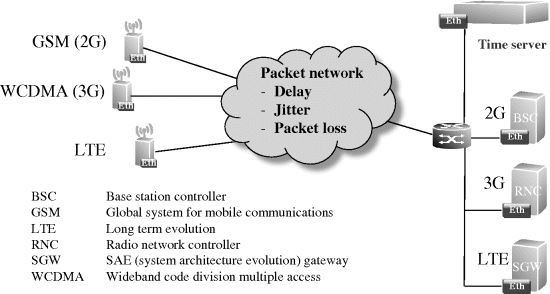6.5 Packet Synchronization Fundamentals and Metrics
In the case of ACR, see Section 6.5.1, the interworking function mapping TDM frames into packets takes care that the pseudowire packets are sent out using a precise packet rate. In the case of NTP and PTP the mobile network operator runs time servers in central locations. A single master typically serves several hundred base stations providing an individual timing packet stream for each. The transport network can be treated as a cloud, which is unaware of the timing streams, see Figure 6.12. The clock recovery algorithm in the base stations is in a key role.
Figure 6.12 Packet timing architecture.

In TDM networks the phase drifts are in the microsecond range, which makes synchronization of the base station relatively straightforward. In packet timing, the delay variation of the packets is the ‘phase variation’ of packet networks. The delay variation in packet based transport networks is up to several milliseconds, two to three orders of magnitude higher. First, the principle of packet synchronization is explained, from where after the scheme to overcome the accuracy problem is discussed.
6.5.1 The Principles of Packet Timing for Frequency Synchronization
For transporting time the master clock sends timing packets to the slave clock. At least two packets are needed to convey frequency, see Figure 6.13. Either the period of the ...
Get Mobile Backhaul now with the O’Reilly learning platform.
O’Reilly members experience books, live events, courses curated by job role, and more from O’Reilly and nearly 200 top publishers.

